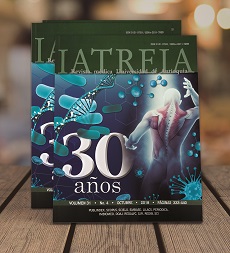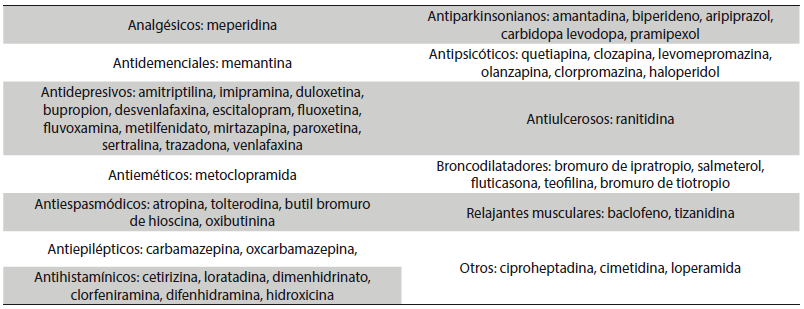Carga anticolinérgica en pacientes mayores de 65 años con tratamiento farmacológico ambulatorio en una población colombiana
DOI:
https://doi.org/10.17533/udea.iatreia.v32n1a03Palabras clave:
adulto mayor, pacientes ambulatorios, polifarmacia, síndrome anticolinérgicoResumen
Introducción: los fármacos con potencial efecto anticolinérgico son prescritos frecuentemente en la población mayor de 65 años. Existen varias escalas para calcular la carga anticolinérgica: Anticholinergic Drug Scale, Anticholinergic Risk Scale y Anticholinergic Cognitive Burden.
Objetivo: caracterizar la carga anticolinérgica en pacientes mayores de 65 años con polifarmacia que son formulados ambulatoriamente.
Métodos: estudio de corte transversal, retrospectivo con información de prescripción registrada desde abril hasta septiembre de 2016. Se utilizó la base de datos transaccional de prescripción de una EPS nacional registrada en la plataforma tecnológica de un PBM (Pharmacy Benefit Management). Se analizaron los medicamentos con propiedades anticolinérgicas y carga anticolinérgica.
Resultados: fueron 115.713 los pacientes formulados, con una edad media de 74 años. Los grupos terapéuticos más asociados con carga anticolinérgica moderada fueron, en un 6,5 %, dimenhidrinato, amantadina, biperideno y quetiapina. Un 13,1 % con carga anticolinérgica alta donde se encuentran el butil bromuro de hioscina y la amitriptilina.
Discusión: el manejo de las patologías en los pacientes adultos mayores es compleja y se llega hasta el punto de requerir prescripción de múltiples medicamentos; por lo cual, se hace fundamental evaluar la necesidad del uso de estos, además de verificar su pertinencia y las posibles interacciones farmacológicas de alta significancia clínica, para evitar la presencia de eventos adversos. Por esto se han desarrollado escalas que permiten mejorar el resultado terapéutico especialmente en fármacos con carga anticolinérgica.
Descargas
Citas
(1.) Gavilan-Moral E, Villafaina-Barroso A, Jiménez-de Gracia L, Gómez Santana M del C. Ancianos frágiles polimedicados: ¿es la prescripción de medicamentos la salida? Rev Esp Geriatr Gerontol. 2012;47(4):137-86. DOI 10.1016/j.regg.2012.01.003.
(2.) Masnoon N, Shakib S, Kalisch-Ellett L, Caughey GE. What is polypharmacy? A systematic review of definitions. BMC Geriatr. 2017 Oct;17(1):230. DOI 10.1186/s12877-017-0621-2.
(3.) Laosa Zafra O, Tardáguila García N, Jordán Bueso J. Programas de farmacovigilancia en el anciano. En: Tratado de medicina geriátrica: Fundamentos de la atención sanitaria a los mayores. Ámsterdam: Elsevier; 2015. p. 56-65.
(4.) Maher RL, Hanlon J, Hajjar ER. Clinical consequences of polypharmacy in elderly. Expert Opin Drug Saf. 2014 Jan;13(1):57-65. DOI 10.1517/14740338.2013.827660.
(5.) Moreno-Gutiérrez PA, Gaviria-Mendoza A, Cañón MM, Machado-Alba JE. High prevalence of risk factors in elderly patients using drugs associated with acquired torsades de pointes chronically in Colombia. Br J Clin Pharmacol. 2016 Aug;82(2):504-11. DOI 10.1111/bcp.12969.
(6.) Colombia. Ministerio de Salud. Informe quincenal epidemiológico nacional: Perfil epidemiológico de las intoxicaciones por sustancias químicas en Colombia, 2008-2015 [Internet]. Bogotá: MinSalud: 2017. Disponible en: https://www.ins.gov.co/buscador-eventos/IQEN/IQEN%20vol%2022%202017%20num%202.pdf
(7.) Mangoni AA, Jackson SH. Age-related changes in pharmacokinetics and pharmacodynamics: basic principles and practical applications. Br J Clin Pharmacol. 2004 Jan;57(1):6-14.
(8.) Parekh N, Ali K, Stevenson JM, Davies JG, Schiff R, Van der Cammen T, et al. Incidence and cost of medication harm in older adults following hospital discharge: a multicenter prospective study in the UK. Br J Clin Pharmacol. 2018 Aug;84(8):1789-97. DOI 10.1111/bcp.13613.
(9.) Klotz U. Pharmacokinetics and drug metabolism in the elderly. Drug Metab Rev. 2009;41(2):67-76. DOI 10.1080/03602530902722679.
(10.) Salbu RL, Feuer J. A Closer Look at the 2015 Beers Criteria. J Pharm Pract. 2017 Aug;30(4):419-424. DOI 10.1177/0897190016663072.
(11.) American Geriatrics Society 2015 Beers Criteria Update Expert Panel. American Geriatrics Society 2015 Updated Beers Criteria for Potentially Inappropriate Medication Use in Older Adults. J Am Geriatr Soc. 2015 Nov;63(11):2227-46. DOI 10.1111/jgs.13702.
(12.) O’Mahony D, O’Sullivan D, Byrne S, O’Connor MN, Ryan C, Gallagher P. STOPP/START criteria for potentially inappropriate prescribing in older people: version 2. Age Ageing. 2015 Mar;44(2):213-8. DOI 10.1093/ageing/afu145.
(13.) Nauta KJ, Groenhof F, Schuling J, Hugtenburg JG, van Hout HPJ, Haaijer-Ruskamp FM, et al. Application of the STOPP/START criteria to a medical record database. Pharmacoepidemiol Drug Saf. 2017 Oct;26(10):1242-7. DOI 10.1002/pds.4283.
(14.) López-Álvarez J, Zea Sevilla MA, Agüera Ortiz L, Fernández Blázquez MÁ, Valentí Soler M, Martínez-Martín P. Efecto de los farmacos anticolinergicos en el rendimiento cognitivo de las personas mayores. Rev Psiquiatr Salud Ment. 2015;8(1):35-43.
(15.) Villalba-Moreno AM, Alfaro-Lara ER, Santos-Ramos B. Anticholinergic risk: Use and limitations of anticholinergic scales. Eur J Intern Med. 2015 Dec;26(10):e65-6. DOI 10.1016/j.ejim.2015.08.014.
(16.) Rojo-Sánchez AM, Vélez-Diaz-Pallares M, Muñoz García M, Delgado Silveira E, Bermejo Vicedo T, Cruz Jentoft A. Carga anticolinergica y delirium en pacientes mayores durante la hospitalizacion en una unidad de agudos de geriatría. Rev Esp Geriatr Gerontol. 2016;51(4):187-248. DOI 10.1016/j.regg.2016.04.004.
(17.) Naples JG, Marcum ZA, Perera S, Gray SL, Newman AB, Simonsick EM, et al. Concordance Between Anticholinergic Burden Scales. J Am Geriatr Soc. 2015 Oct;63(10):2120-4. DOI 10.1111/jgs.13647.
(18.) Carnahan RM, Lund BC, Perry PJ, Pollock BG, Culp KR. The Anticholinergic Drug Scale as a measure of drug-related anticholinergic burden: associations with serum anticholinergic activity. J Clin Pharmacol. 2006 Dec;46(12):1481-6.
(19.) Hsu WH, Wen YW, Chen LK, Hsiao FY. Comparative Associations Between Measures of Anti-cholinergic Burden and Adverse Clinical Outcomes. Ann Fam Med. 2017 Nov;15(6):561-9. DOI 10.1370/afm.2131.
(20.) Pont LG, Nielen JT, McLachlan AJ, Gnjidic D, Chan L, Cumming RG, et al. Measuring anticholinergic drug exposure in older community-dwelling Australian men: a comparison of four different measures. Br J Clin Pharmacol. 2015 Nov;80(5):1169-75. DOI 10.1111/bcp.12670.
(21.) Gorzoni ML, Alves Fabbri RM. Applicability of Anticholinergic Risk Scale in hospitalized elderly persons. Rev Bras Geriatr Gerontol. 2017;20(1):123-8. DOI 10.1590/1981-22562017020.150191.
(22.) Gray SL, Anderson ML, Dublin S, Hanlon JT, Hubbard R, Walker R, et al. Cumulative use of strong anticholinergics and incident dementia: a prospective cohort study. JAMA Intern Med. 2015 Mar;175(3):401-7. DOI 10.1001/jamainternmed.2014.7663.
(23.) Mayer T, Kopitz J, Plaschke K, Weiss J, Seidling HM, Haefeli WE. Limitations of the Anticholinergic Activity Assay and Assay-Based Anticholinergic Drug Scales. Am J Geriatr Psychiatry. 2016 Dec;24(12):1182-8. DOI 10.1016/j.jagp.2016.07.024.
(24.) Rudolph JL, Salow MJ, Angelini MC, McGlinchey RE. The anticholinergic risk scale and anticholinergic adverse effects in older persons. Arch Intern Med. 2008 Mar;168(5):508-13. DOI 10.1001/archinternmed.2007.106.
(25.) Kose E, Hirai T, Seki T. Assessment of aspiration pneumonia using the Anticholinergic Risk Scale. Geriatr Gerontol Int. 2018:1230-5. DOI 10.1111/ggi.13454.
(26.) Jyrkkä J, Enlund H, Korhonen MJ, Sulkava R, Hartikainen S. Patterns of drug use and factors associated with polypharmacy and excessive polypharmacy in elderly persons: results of the Kuopio 75+ study: a cross-sectional analysis. Drugs Aging. 2009;26(6):493-503. DOI 10.2165/00002512-200926060-00006.
(27.) Urfer M, Elzi L, Dell-Kuster S, Bassetti S. Intervention to Im Patients Admitted to an Internal Medicine Unit. PLoS One. 2016 Nov;11(11):e0166359. DOI 10.1371/journal.pone.0166359.
(28.) Shah BM, Hajjar ER. Polypharmacy, adverse drug reactions, and geriatric syndromes. Clin Geriatr Med. 2012 May;28(2):173-86. DOI 10.1016/j.cger.2012.01.002.
(29.) Salahudeen MS, Hilmer SN, Nishtala PS. Comparison of anticholinergic risk scales and associations with adverse health outcomes in older people. J Am Geriatr Soc. 2015 Jan;63(1):85-90. DOI 10.1111/jgs.13206.
(30.) Villalba-Moreno AM, Alfaro-Lara ER, Pérez-Guerrero MC, Nieto-Martín MD, Santos-Ramos B. Systematic review on the use of anticholinergic scales in poly pathological patients. Arch Gerontol Geriatr. 2016 Jan-Feb;62:1-8. DOI 10.1016/j.archger.2015.10.002. Erratum in: Arch Gerontol Geriatr. 2016 May-Jun;64:178-80.
(31.) Lertxundi U, Domingo-Echaburu S, Hernandez R, Peral J, Medrano J. Expert-based drug lists to measure anticholinergic burden: similar names, different results. Psychogeriatrics. 2013 Mar;13(1):17-24. DOI 10.1111/j.1479-8301.2012.00418.x.
(32.) Narayan SW, Hilmer SN, Horsburgh S, Nishtala PS. Anticholinergic component of the Drug Burden Index and the Anticholinergic Drug Scale as measures of anticholinergic exposure in older people in New Zealand: a population-level study. Drugs Aging. 2013 Nov;30(11):927-34. DOI 10.1007/s40266-013-0111-y.
(33.) West T, Pruchnicki MC, Porter K, Emptage R. Evaluation of anticholinergic burden of medications in older adults. J Am Pharm Assoc (2003). 2013 Sep-Oct;53(5):496-504. DOI 10.1331/JAPhA.2013.12138.
(34.) Tisdale JE. Drug-induced QT interval prolongation and torsades de pointes: Role of the pharmacist in risk assessment, prevention and management. Can Pharm J (Ott). 2016 May;149(3):139-52. DOI 10.1177/1715163516641136.
(35.) Khan Q, Ismail M, Haider I, Ali Z. Prevalence of the risk factors for QT prolongation and associated drug-drug interactions in a cohort of medical inpatients. J Formos Med Assoc. 2018 Feb. pii: S0929-6646(17)30607-1. DOI 10.1016/j.jfma.2018.01.016.
(36.) World Health Organization. Clinical pharmacology in health care, teaching and research [Internet]. Geneva, Switzerland: WHO; 2012. Available from: http://apps.who.int/medicinedocs/documents/s19916en/s19916en.pdf
Publicado
Cómo citar
Número
Sección
Licencia
Derechos de autor 2019 Iatreia

Esta obra está bajo una licencia internacional Creative Commons Atribución-CompartirIgual 4.0.
Los artículos publicados en la revista están disponibles para ser utilizados bajo la licencia Creative Commons, específicamente son de Reconocimiento-NoComercial-CompartirIgual 4.0 Internacional.
Los trabajos enviados deben ser inéditos y suministrados exclusivamente a la Revista; se exige al autor que envía sus contribuciones presentar los formatos: presentación de artículo y responsabilidad de autoría completamente diligenciados.















